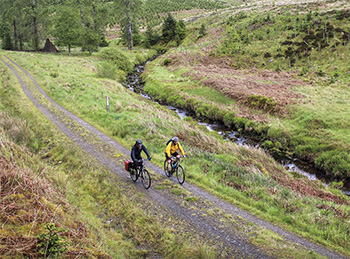
..........................................................................................................................................................................................................
cycling the reivers route - rachel crolla and carl mckeating. cicerone press paperback. 126pp illus. £11.95

reivers were probably not the sort of folks you'd invite along on the sunday bike ride, not least because their heyday was long before kirkpatrick macmillan took a bike ride to glasgow and knocked somebody over. but, aside from the lack of a bicycle, reivers were allegedly not the sort of folks you'd want to meet in an alley after dark.
according to history, their glory days were between the 16th and 17th centuries, drawn from both sides of the scotland/england border. the fact that both countries were frequently at war with each other, and the reivers' remoteness from both centres of power, meant there was often little incentive to curtail their activities. livestock was easily rustled and driven by mounted reivers who knew the country well. they were also renowned for removing easily portable household goods or valuables, and every now and again, where they thought there might be money, they'd take prisoners for ransom.

thankfully, at least for those who lived each side of the border, there's no longer a need to build fortified tower houses in which to remain safe from attack, or to build stone walls surrounding their properties, within which they might keep their livestock safe from these marauders. in 1609, an act of parliament set a law to deal with criminals in the border region, stretching as far as allowing the trial of an english subject in scotland, if the felony had been committed there. despite calls for scottish independence nowadays, it's currently a great deal safer at the border, to the extent that you can now ride where once folks feared to tread, following in the hoofprints for the reivers.

the reivers route as defined in this excellent guide from messrs. crolla and mckeating, stretches from whitehaven in the lake district, all the way across country to tynemouth on the north sea coast of county durham. it's a route covering approximately 275km and thoughtfully portioned into a four day excursion by the authors. but, other than a desire to be your own less objectionable reiver on two wheels, why is this a route worthy of your attention?
according to the authors, "The Reivers Route is a wilder, hillier and more challenging undertaking than Sustrans' other northern coast-to-coast rides. Its remote sections and superb lengthy off-road passages are all part of its appeal." for those reasons, the authors advise undertaking the ride over a period of four days, though i daresay the more intrepid amongst our number may think nothing of riding such varied terrain in half the time. but in truth, how tough is the ride? "(it's) an attainable goal for most people. If you can comfortably ride 40 miles (65km) with 900 metres of ascent and still clamber back onto your saddle the next day, then you will be more than able to tackle the four day itinerary."

the above description would tend to suggest that a tadej pogacar limited edition colnago might not be your first choice of bicycle on which to ride from whitehorn to tynemouth. the authors suggest either a rugged touring bike, hybrid or gravel bike. something with clearance for 42mm tyres would apparently be just ginger peachy. however, with that in mind "mountain bikes are not suitable for the Reivers and Borderers cycle tours, as the majority of the miles are done on tarmac." and just in case pogacar was thinking about it, "they are definitely not suitable for road bikes", meaning there's little chance of being beaten to the sprint in tynemouth by wout van aert.

as has become common with all of cicerone's cycling guides, the preamble lists the equipment you'd be best to consider, whether to stuff it all inside panniers or bike-bags, what sort of clothing might prove appropriate, and why they'd recommend you wear a helmet. i'd tend to agree that the maps provided in the book are more than equal to the task, while the book's compact and bijou format lends itself to its being ensconced in a jersey rear pocket. according to the last page in the book, the entire route is downloadable as gpx files for uploading to your gps device, in case flicking through paper maps is just not your thing.

this sort of bike ride, however, is not really this sort of bike ride, unless you can learn a thing or two along the way. thus, at frequent stop-off points throughout the parcours, there are informative box-outs, just in case you fancy being a know-it-all when you visit relatives after your successful completion. "In 1525, a Scottish archbishop put a curse on all the Border Reivers. For Carlisle's Millennium celebrations in 2000, the city council thought it a good idea to have the 1000-word curse carved as an artwork onto a granite boulder. Some blamed the carving for the city's post-millennial flooding..."
aside from comprehensive maps, turn-by-turn directions, copious colour illustrations and localised descriptions as shown above, each stage is illustrated with a profile displaying the distance and ascending that lies ahead. and if you intend to emulate the reivers' antics, just ensure your panniers are large enough to cope with cattle and sheep.
sunday 25 july 2021
 ..........................................................................................................................................................................................................
..........................................................................................................................................................................................................